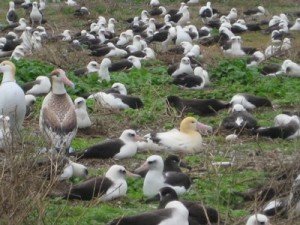After a rainy start, we headed to Sand Island’s rugged neighbor, Eastern Island, where we saw many rare seabirds who amazed and intrigued us. We are looking for help in naming our hatching albatross chick. Any suggestions?
This morning started off with a steady rain. So, we spent the morning indoors listening to talks on climate change by Professor Dave Johnston and environmental journalist Eugene Linden. We learned how sea level rise will affect the amount of habitat available to monk seals and how important it is to create stable populations of seals within the main Hawaiian island to support those in the Northwestern Hawaiian Islands during times of climate variability. We also realized the importance of educating the public on monk seal issues and in general, supporting our messages with scientific data. After the morning indoors, we headed outside where it was still rainy and according to my estimates, in the low 60s.
After lunch, which was “Sandwich Tuesday” (a favorite on the island), we loaded our bags with the usual: cameras, notebooks, snacks, and of course rain gear. Although the afternoon started out sunny, the weather on Midway can be as variable as the predictions for climate change. We were on our way to Eastern Island, a neighbor of Sand Island and Spit Island at Midway Atoll, and as we approached the island I began to feel a sense of remoteness from being on an island half way in the middle of the Pacific Ocean. Our boat pulled up alongside Eastern and we each had to climb a ladder up the side of the pier before we could step foot on solid ground.

Compared to Midway, Eastern has a much more rugged feel to it. It is a fairly barren looking landscape with no trees, a fair amount of bushes, and thorny plants underfoot. No bowling alley, bar, barracks, or library: Eastern is truly a place that’s for the birds…and there were plenty. We started our tour, led by John Klavitter, at the site of a cannon left over from World War II that is now surrounded by Albatross nests. Unfortunately for us, these birds were not so friendly as those on Sand Island, and two of our intrepid travelers got a quick nip on the ankle from getting too close to the nests.

Our next stop was the site of one of the refuge’s restored freshwater wetlands. Here, native bunch grass had been planted and was successfully harboring a group of Laysan Ducks, also known as Laysan Teals. As mentioned in Dave’s blog (Day Seven (1/19/08), these ducks were reintroduced to the island in 2004/2005 and have since successfully bolstered the population of the world’s most endangered duck!
We then hiked on, weaving through albatross nests, to the spot of the Golden Goonie. Along the way, four or five small white terns, also known as the common fairy-tern, began hovering around our group. We had all noticed them on Sand Island, but had never heard them and to our surprise they make a low grunting sound, very un-fairy like. A little further on we began to notice what looked like very tall and stiff fake birds, and we were right! We had entered the land of the decoys. Set here to attract the Short-Tailed Albatross (also known as the Golden Goonie) these decoys had successfully lured one adult short-tailed bird. They were in fact so successful that the live bird has been seen dancing with its ‘favorite decoy” since 1999. Luckily, the real short-tailed was in full display for us to enjoy. Much bigger than the Laysan Albatross (it actually reaches the height of the decoy seen in the picture) this goonie has yellow coloration on its head and neck and a long pinkish bill. It is a beautiful bird and we all realized how extremely fortunate we were to have seen it. It is possible that this whole experience may have turned a group of mostly marine mammal enthusiasts into birders.

As we made our way to the opposite edge of the island, masked and red-footed boobies soared overhead next to the ever-present albatross. The red-footed is a particularly stunning bird with bright feet and turquoise markings around the eyes. In addition to our island tour, we were also searching for a lost satellite transmitter that had just recently begun sending signals from somewhere along the coast of Eastern. Originally attached to one of the Northwestern Hawaiian Island native monk seals, this transmitter was likely shed after the seal had molted on the beach, a process in which the animal sheds its entire top layer of skin and fur. Thanks to eagle eye Andy Read, the transmitter was found, and we will be able to find out the depths the seal traveled to as well as the temperature of the water during its journeys. After our success, we headed back toward where we began our tour and along the way witnessed the mating ritual of the frigate bird: the male enlarges a bright red throat pouch and spreads its wings in hopes of attracting a female. As we boarded our boat, two Laysan Ducks flew by and I realized how lucky we all were to see some of the rarest animals in one of the most remote places on earth. Thank you to everyone who has made this possible!
Hatching update: Since our discovery of the piping albatross outside our hotel, we have been closely monitoring its progress. We have decided to call the hatching chick Moli, the Hawaiian name for Laysan Albatross, but we are open to suggestions. So far, not much to record. The hole in the egg has grown larger and we can see the tiny bird moving inside the egg. Hopefully, we’ll see some real action tomorrow. Stay tuned!

Update 02/01/08:
The satellite tag we found was returned to its owner – Dr. Charles Littnan – and he successfully downloaded more than three months of diving data from the tag. These data show how the tagged seal dove in search of food during the deployment and these dive profiles are extremely useful for understanding how seals learn to forage. Charles sent us a graph of the data to illustrate the general diving patterns of the seal who wore the tag.


It has been great reading your daily adventures, you guys are doing a great job in educating us, you are lucky to be there and hurray to the Nicholas school of environment for providing you this oppurtunity.I think you should call the chick Nicky ,after Nicholas you deserve to leave behind something to be remembered. Have a safe trip home.